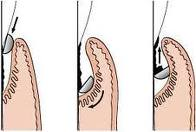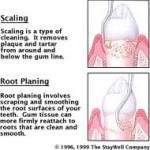Deep gum cleaning consists of scaling and root planing. Gum disease (gingivitis) if untreated can progress to more
serious periodontal disease (bacterial/viral proliferation which overwhelms the host immune response) causing destruction of the supporting tissues of the teeth and bone loss which are irreversible in nature. A periodontal pocket forms and harbors bacteria in large amounts. Deep scaling and root planning are the therapeutic procedures performed to heal your gums by removing the disease causing toxins. Scaling is the process of removing dental tartar from the teeth surfaces while root planning involves removing infected tooth structure (dentin and cementum) and smoothing the rough root surfaces of the teeth. The goal of active therapy is to remove as much subgingival debris as possible and disrupt/ the bacterial proliferation.
How Is Scaling and Root Planing Done?
Scaling and root planning are done using ultrasonic scalers and hand instruments. Ultrasonic instrument works in two-ways, metal tip which dislodges the hard calculus and a water irrigation system that cools the tip and flush out debris from around the teeth. A sharp hook like scraping tool with a cutting edge is used to engage deep inside between teeth and gums, bringing out calculus, tartar, diseased dentin, micro-organisms, debris and food particles buried in there. Pulling strokes are usually used when doing this procedure. Thin curettes are used for root planning. Tactile sensation is used to feel for roughness on the root surface. Local anesthesia is required in certain cases depending on the severity and progress of the disease to manage any discomfort. Deeper pockets and extensive rough root surfaces may need more than one appointment in the case of severe periodontitis. Gum curretage is the procedure of removal granulation tissue and inflamed tissue wall of a periodontal pocket (area surrounding a tooth). Gum curretage can be performed along with scaling and root planning procedure or as a separate procedure.

root planning
Why Are These Procedures Done?
A prophylaxis cleaning only removes soft sticky plaque on tooth surfaces above the gum line and polishing with pumice using a rubber cup. It is done in people with little bone loss and minor, localized pockets as a general procedure during the routine dental visit. It is different from periodontal maintenance therapy after periodontal treatment which controls the disease progression. As said earlier, plaque and tartar left on teeth invites bacteria and enhances their growth. Plaque hardens over time to form calculus. They irritate the gums causing them to bleed easily during brushing or even eating. This is the early stage of gum disease called gingivitis. It can be controlled with an antiseptic mouthwash, proper brushing, regular flossing, scaling and polishing. A root planed root surface rendered free of tartar and calculus, has a better chance of allowing gum tissues to heal and reattach to roots, preventing tooth loss and sensitivity problems. Most deep gum pockets are reduced after a deep cleaning. Adjunctive local antibiotics in form of gel are placed in deeper pockets. Gum and bone care is followed as a supportive periodontal maintenance phase. The goal in periodontal maintenance is to debride the sulcular areas of attached and non-attached plaque pathogens. Gum surgery is usually performed to reestablish good oral hygiene.
What Is The Outcome of Deep Gum and Root Cleaning?
Pockets shrink and gums recede after successful periodontal treatment. Depending on the initial pocket depth and severity of periodontitis, deep pockets will shrink more and hence teeth appear longer. More root surface is exposed and you will experience sensitivity to changes in temperature. Your dentist will normally apply a protective material over the tooth surface to control the sensitivity. Pain and discomfort will occur after the treatment. Bleeding may be present for a few days as the inflammation decreases. Rinse your mouth with a chlorhexidine mouthwash to reduce the levels of bacteria in the mouth. On the other hand, warm salt water rinse few times throughout the day will encourage gum healing and sooth discomfort. Avoid spicy foods and hot drinks, opt for a soft healthy diet and plenty of liquids. Brush the area gently to prevent bruising the tender gums and floss as told to keep the area clean free of bacteria that causes plaque build-up. Do not smoke or chew tobacco as it worsens the situation. Over-the-counter painkillers like ibuprofen will help to alleviate the pain. Take great care to avoid aspirin as they aggravate bleeding. Active periodontal therapy and meticulous good oral hygiene can halt the progression of the disease and render gums and teeth healthy over a period of time.
